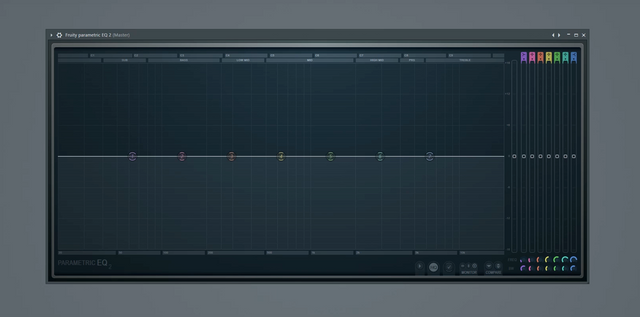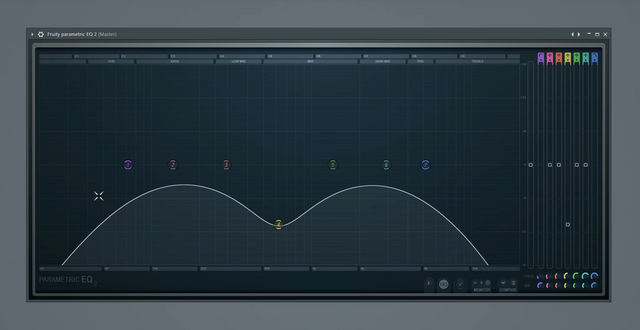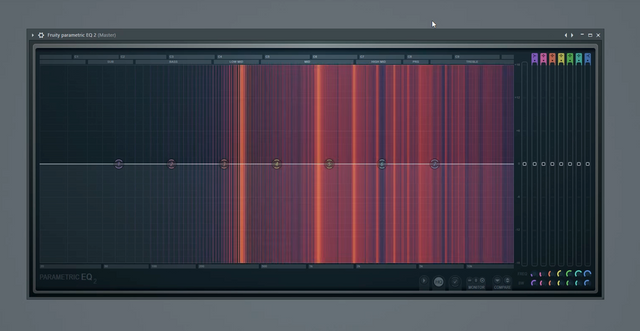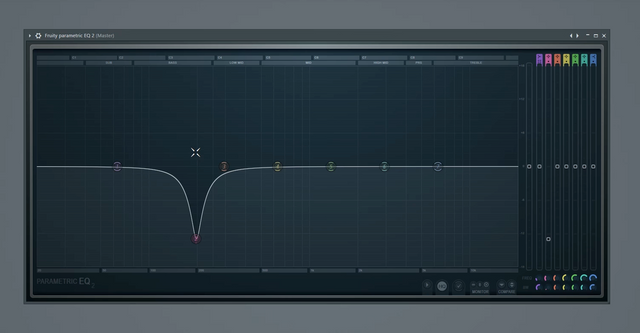Welcome to the EQ tutorial by the end of you should have a strong foundation on what EQ is how to use it properly and why it's an essential tool in your projects for the purposes. I want to be using my favourite equalizer plug-in and that is the fruity parametric EQ - however the knowledge that you learn can be applied to any equalizer within any DAW of your choice every single sound that you hear is made up of frequencies and a frequency is a cycle per second the range that the human ear can detect in audio frequencies is roughly 20 Hertz all the way up to 20,000 Hertz or 20 kilohertz this is called the frequency spectrum so every single sound that you can perceive falls within this range and this range is the typical range of most equalizers 20 Hertz all the way up to 20,000 Hertz

Animals like dogs are known to be able to detect frequencies upwards of 50 kilohertz so if dogs were making music they'd have a lot more frequencies to worry about than us so no excuse humans different types of sounds and instruments tend to live in certain regions on the frequency spectrum for example drum sounds or percussive sounds like your high hats your snares your claps those tend to live up here in the treble and high mid region sounds like your leads your pads or vocals or guitars stuff like that those tend to live in this mid region right here low mid to high mid and sounds like bass lines and your kick drums tend to predominantly live down here in the sub and bass regions of course all these sounds can bleed over into surrounding regions but the regions that I just outlined are kind of where most of the frequency content of these particular sounds resides let's look at some examples here's a kick drum

Now kick drums are one of the few instruments that actually does have frequency content pretty much throughout the whole spectrum as you can see when it comes in it sort of comes in strongly around the mid region and then sort of drifts down into the sub region there's a little bit of treble as well take a look now the initial part of the kick the transient or the snap that's the stuff that's happening from the treble all the way down to the low mid region the part of the kick that you feel in your chest or in the ground or if you have a good enough sound system the with the subwoofer outputs that's down here in this region around 150 Hertz and below here's a clap now as you can see there's a lot more stuff going on in this upper mid to treble region there's also a little bit happening down here in about the one hundred and sixty Hertz region and this is kind of giving it a little bit of low-end as well here's the hi-hat as you can see it's much more predominantly high mid to treble and it sort of just fades out as it gets lower than that there's really not much going on below the low mid region and even the mid to low mid there's just not too much happening there as well here's the baseline
Now this particular bass line has a good amount of mid to low mid stuff going on in addition to the sub and bass frequencies here's a pluck as you can see lots of mid good amount of highs treble and really no bass so sound like this would actually mix really well with your bass stuff since it kind of gets out of the way right here at the low mid section by now you should be somewhat familiar and comfortable with the frequency spectrum so let's talk about EQ what is EQ EQ is a tool technique and an art for shaping or carving your sounds it can help eliminate or tame unwanted or resonating frequencies or it can accentuate the ones that you want it can help clear up your mix by preventing different sounds from fighting over the same frequency region and when using conjunction with compression it's a very powerful way of processing your sounds to your liking and by the way if you haven't seen my tutorial on compression yet I highly recommend you check that out I'll give a link to it right here now what we have here is what's called a seven band equalizer one two three four five six seven these seven bands serve as control points along the frequency spectrum that let you manipulate the sound each of these bands have properties associated with them these properties are frequency or where along the frequency spectrum you want the sound to be affected amount so this is set in decibels if you look in the top left as I move this up you see the decibel count so a positive number means you're boosting or accentuating the decibels and a negative number means you're cutting or eliminating certain frequencies at this point the next property
 s shape or type so by default with this equaliser bands two through six are set as peaking type so that just means that they look like this sort of bell curve type shape bands one and seven are set to shelves Oh banned one is a low shelf so as you can see it looks a little different from band four then four kind of sweeps down on both sides as I bring it down whereas band one sweeps down on one side and then stays down for the entire rest of the spectrum that's called a shelf and then band seven is the opposite of band one it's a high shelf so when I bring this down you'll see that it has the opposite effect of a low shelf it stays down to the right of the spectrum as it's going down and by no coincidence at all that I create a pair of breasts any of these bands can have their shape or type changed at any time and to do that you can right-click on the band and go to type and it will show you the list of all the available types let's look at some of these so right now by default band one is a low shelf if we change it to a high pass we'll see that it's a little different from a low shelf a high pass basically states that any frequencies above where this band is are allowed to pass hence the name high pass the opposite of a high pass which we're going to set to number seven is a low pass any frequencies lower than where the band is set are allowed to pass so basically again one and seven are opposite in that one is a high pass seven is now a low pass so what's different from a high pass and a low shelf is that a low shelf goes down and then stays at a certain value a high pass cuts off completely at a certain value so a high pass which band one is set to currently will allow less frequencies to come through because it's completely cutting off the ones that fall to the left of this band feel free to go through and play with all the other shapes there's not too many other ones but you'll see how they affect the shape of your EQ curve and you can also play with them with audio obviously to see the kind of effect they have in your sound the next property that each band has has like three names but they all mean the same thing bandwidths resonance or cue literally the letter Q this determines how wide or narrow your band is affecting the sound in this equalizer there are two ways of affecting this value if you come down here to the speed W knob and move it up and down you can see it changing the width of this band my preferred method is to come over to the band itself and mouse over and just use the mouse wheel so something like this is a much narrower band and will affect only a certain limited number of frequencies versus something like this which is a much wider band this will affect a lot more surrounding frequencies at a exponentially less rate as it moves further away from this band another parameter that this equalizer gives you per band is how steep you want each slope to be so for example with band number seven I'm going to come down and go to order and you'll see that it's on two by default two is the gentlest slope that you can have in this equalizer so if I change it to something like steep eight you'll see that it creates a very steep slope and basically any treble that comes to this point is really not going to pass this equalizer band so this band is going to sharply cut anything right at the 5000 Hertz range if I change it to something like gentle 4 you'll see that it's a much gentler slope closer to 2 but not quite as gentle and this is just one of the many ways you can sort of shape each of these bands and of course in conjunction with that steep setting you can play with the bandwidth as well to really hone in on a customized slope for your liking now just to quickly recap we've got shape or type which can be set up here as well we've got a mount and this is in decibels again lower means you're cutting higher means you're boosting we've got frequency so this is where along the spectrum you want the and to affect and then you have bandwidth aka cue or resonance the narrowness or width of the band and then finally if you right-click and come to order you also have the Steep option using these five parameters across up to seven bands can really help you shape and carve sounds to your liking now just remember that EQ e is absolutely an art there is no right or wrong way to EQ a sound everything you do in an equalizer similar to how it's done in a compressor is done to taste it all depends on what you're trying to accomplish or what sound you're going for now before I have done in this equalizer to the unaltered state so let's do thatevery single sound has its own special requirements or needs of Equalization depending on the situation or project that you're working in so there's really no way that I or anyone else can tell you how to equalize every single sound so what I recommend you do is you get comfortable with Equalization get good at using the tools that I've shown you and the techniques and before you know it equal izing will become second nature to you and you'll start equalizing things exactly to your liking combined with compression it's a very powerful way of processing sounds and making them sound really good in the mix.
s shape or type so by default with this equaliser bands two through six are set as peaking type so that just means that they look like this sort of bell curve type shape bands one and seven are set to shelves Oh banned one is a low shelf so as you can see it looks a little different from band four then four kind of sweeps down on both sides as I bring it down whereas band one sweeps down on one side and then stays down for the entire rest of the spectrum that's called a shelf and then band seven is the opposite of band one it's a high shelf so when I bring this down you'll see that it has the opposite effect of a low shelf it stays down to the right of the spectrum as it's going down and by no coincidence at all that I create a pair of breasts any of these bands can have their shape or type changed at any time and to do that you can right-click on the band and go to type and it will show you the list of all the available types let's look at some of these so right now by default band one is a low shelf if we change it to a high pass we'll see that it's a little different from a low shelf a high pass basically states that any frequencies above where this band is are allowed to pass hence the name high pass the opposite of a high pass which we're going to set to number seven is a low pass any frequencies lower than where the band is set are allowed to pass so basically again one and seven are opposite in that one is a high pass seven is now a low pass so what's different from a high pass and a low shelf is that a low shelf goes down and then stays at a certain value a high pass cuts off completely at a certain value so a high pass which band one is set to currently will allow less frequencies to come through because it's completely cutting off the ones that fall to the left of this band feel free to go through and play with all the other shapes there's not too many other ones but you'll see how they affect the shape of your EQ curve and you can also play with them with audio obviously to see the kind of effect they have in your sound the next property that each band has has like three names but they all mean the same thing bandwidths resonance or cue literally the letter Q this determines how wide or narrow your band is affecting the sound in this equalizer there are two ways of affecting this value if you come down here to the speed W knob and move it up and down you can see it changing the width of this band my preferred method is to come over to the band itself and mouse over and just use the mouse wheel so something like this is a much narrower band and will affect only a certain limited number of frequencies versus something like this which is a much wider band this will affect a lot more surrounding frequencies at a exponentially less rate as it moves further away from this band another parameter that this equalizer gives you per band is how steep you want each slope to be so for example with band number seven I'm going to come down and go to order and you'll see that it's on two by default two is the gentlest slope that you can have in this equalizer so if I change it to something like steep eight you'll see that it creates a very steep slope and basically any treble that comes to this point is really not going to pass this equalizer band so this band is going to sharply cut anything right at the 5000 Hertz range if I change it to something like gentle 4 you'll see that it's a much gentler slope closer to 2 but not quite as gentle and this is just one of the many ways you can sort of shape each of these bands and of course in conjunction with that steep setting you can play with the bandwidth as well to really hone in on a customized slope for your liking now just to quickly recap we've got shape or type which can be set up here as well we've got a mount and this is in decibels again lower means you're cutting higher means you're boosting we've got frequency so this is where along the spectrum you want the and to affect and then you have bandwidth aka cue or resonance the narrowness or width of the band and then finally if you right-click and come to order you also have the Steep option using these five parameters across up to seven bands can really help you shape and carve sounds to your liking now just remember that EQ e is absolutely an art there is no right or wrong way to EQ a sound everything you do in an equalizer similar to how it's done in a compressor is done to taste it all depends on what you're trying to accomplish or what sound you're going for now before I have done in this equalizer to the unaltered state so let's do thatevery single sound has its own special requirements or needs of Equalization depending on the situation or project that you're working in so there's really no way that I or anyone else can tell you how to equalize every single sound so what I recommend you do is you get comfortable with Equalization get good at using the tools that I've shown you and the techniques and before you know it equal izing will become second nature to you and you'll start equalizing things exactly to your liking combined with compression it's a very powerful way of processing sounds and making them sound really good in the mix.
